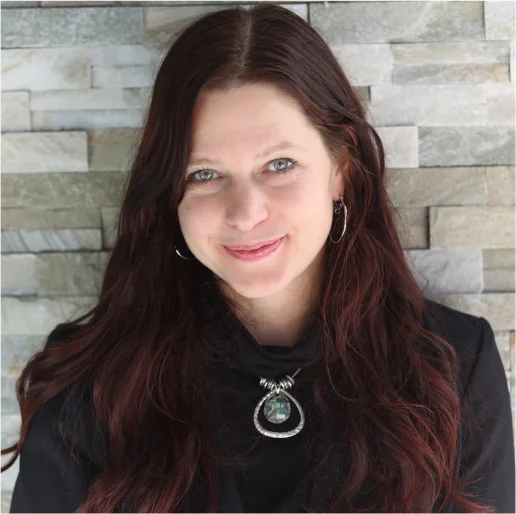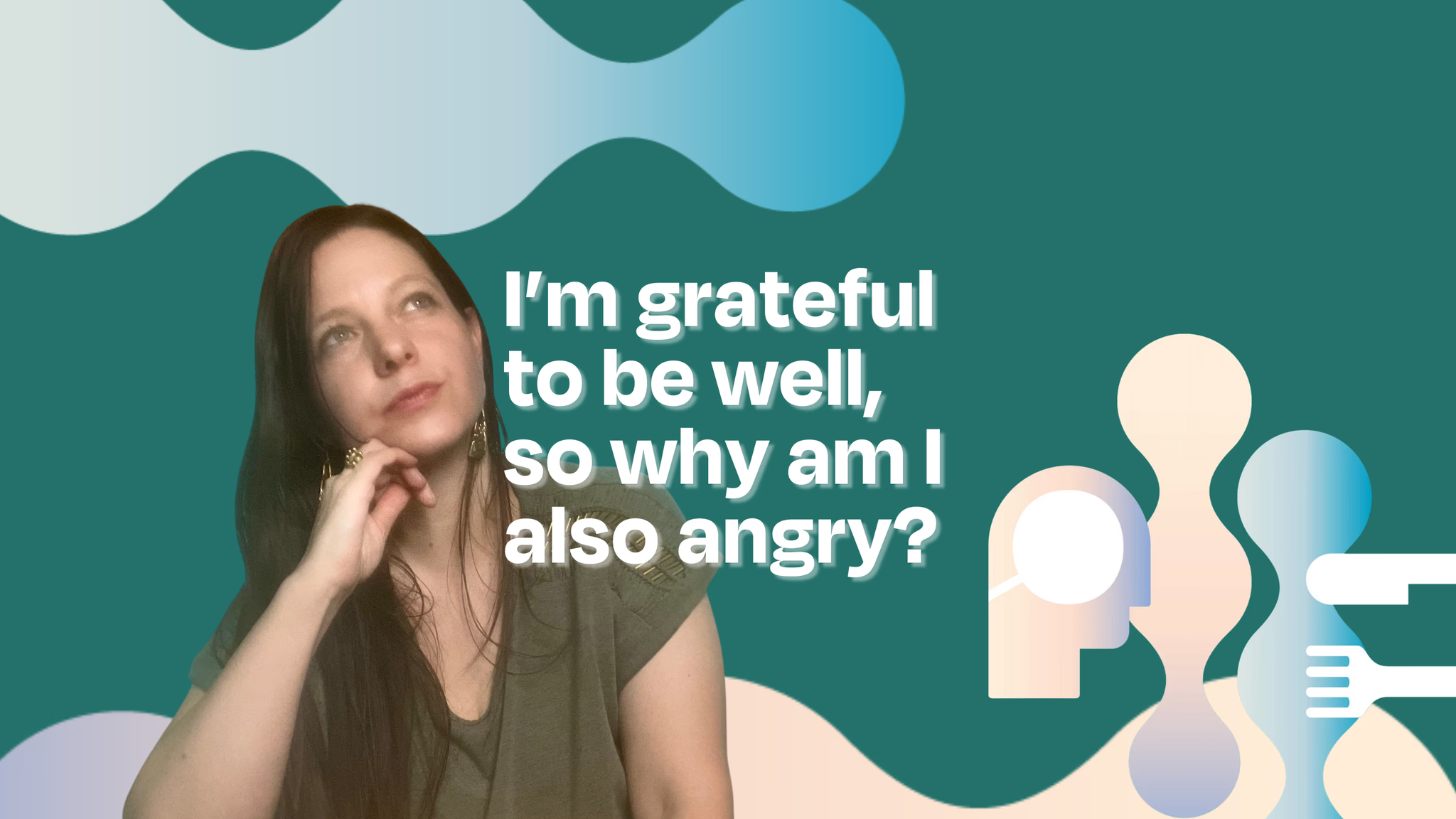In the summer of 2021, while listening to podcasts about spiritual transformation, I spent countless hours painting my kitchen cabinets teal and stenciling them with ornate golden designs. I had been off of antipsychotic medication for one year. Life felt magical, yet I knew something wasn’t right because I had too much energy. I rarely sat down. I always had to be busy with a task, like cleaning or home renovations. I never got a full night of sleep. I began to question my mental stability, and worried that, once again, I was teetering on the edge of another world.
One afternoon, I went for a jog to burn off the excess energy I felt invading my cells. When I hit the three-mile mark on my riverside run, I didn’t turn back home as usual. Instead, I crossed over a bridge to a path on the other side of the river that winds between small forested limestone cliffs and an abandoned railroad track. I didn’t quite realize it, but I was also crossing into an alternate reality.
On the path, I made eye contact with an emaciated man on a bicycle who came to a sudden stop beside me. “I’m an artist,” he said, pulling a red rock from his pocket. I stared at it, transfixed by a gold geometric symbol that appeared magically lenticular. “I paint rocks and hide them along the river path for children to find. The rocks bring God to the Earth,” he said. “To find him, just look up.” He pointed to the sky. His large, frenetic eyes were a disorienting shade of hazel, muddy and almost colorless, until I looked closely and discovered vibrant splinters of green and blue.
“I see him,” I said.
I was no longer teetering on the edge of delirium. I had descended, and I no longer recognized my illness. Being suddenly swallowed by psychosis is like falling asleep while awake. It’s navigating the world like a sleepwalker, oblivious to dangers. It’s the opposite of a lucid dream, one where you become aware you are dreaming. In a psychotic state, reality doesn’t return when you open your eyes.
The rock painter, one of God’s trusted coworkers, invited me to join him at a free water ski gymnastics show.
“Yes!” I said enthusiastically.
We sat on bleachers in the park and watched teenagers maneuvering on water skis, their bodies gracefully flipping about, periodically suspended in gravity-defying positions. The orange evening sun glistened off the water and the sequins on their costumes, and illuminated their faces with glints of light. I was sure they were transcendent beings, angels granted special permission to visit Earth. They were there to usher me into the better universe I could feel permeating the air around me.
A Third Hospitalization, Medicated for Manic Psychosis
I was admiring the unearthly beauty of the riverfront park when my dad called. I felt like I could feel every single particle around me vibrating, and see them radiating color. “I am in a beautiful impressionist painting that has come alive, surrounded by angels,” I told him.
My dad, a retired newspaperman, rushed to the park where I sat at a picnic table looking up at the trees as the sun set. I was discussing holy water with the artist, who my dad later told me reeked of alcohol. “I’m taking you to the hospital,” he said, running his hand through his thick gray hair. He was wearing a plaid button-down shirt and looked worried. I agreed to go to the hospital, believing I would soon be untethered, and granted permission to move freely between Heaven and Earth.
At the hospital, I was put back on Olanzapine, the antipsychotic I had been taking for most of the last ten years. After my first psychotic episode in 2012, I took it for six months before I tried going off. During that half year, I had rapidly put on more than seventy pounds and I hated the way I felt on the medication. I’d experienced suicidal depression, blunted emotions, and impaired cognition. I felt sedated all the time. When I stopped taking the medication, I worked hard to lose the weight I had gained, and started to feel better. But, within a year, I was back in the clutches of mania. That’s when a doctor told me I had bipolar 1 disorder, a chronic, lifelong illness. I needed to stay on medication indefinitely, and endure the debilitating side effects, if I wanted to be a functional, responsible human being.
For seven years, I was in mourning and felt like a part of me had died. I forced myself to accept that my life would never again be like it was prior to my diagnosis. I would need to adapt to a new normal. I would be sedated and sluggish, but sane. I lived that way, until I couldn’t bear it any longer. I didn’t want to be drugged and have poor physical health. I didn’t want to sacrifice all the things I enjoyed about life in exchange for mental stability. It was a cruel, unbearable trade-off, and I felt that my best years were passing me by. The onset of the pandemic in 2020 reinforced the uncertainty and transience of life and after many years of stability, I decided to experiment going off medication again.
In the time leading up to my 2021 hospitalization, I had begun to improve my life with holistic life-enhancing practices, which made stopping medication seem justifiable. I had given up drinking, and began meditating, journaling and exercising regularly. I routinely practiced intermittent and extended fasting. I loved the feeling I got while fasting, and felt compelled to do it frequently. I had lost weight, my energy levels, focus, creativity, and quality of thought had started to return. I was beginning to feel like myself again for the first time in years. I was even starting to believe I had a bright future, free of mania and psychosis, where my perception would no longer become disjointed from reality. But seeing water skiing teenage angels made it clear that everything I was doing to be stable wasn’t enough.
A Light in the Darkness: The Brain Energy Theory Gave Me Hope
When I got out of the hospital, reality and suicidal depression set in. I knew what lay ahead of me in a life on Olanzapine: weight gain, suicidality, blunted emotions, and impaired cognition. One of my first rational thoughts as the last bits of delusional thinking disintegrated was, “Can I really survive this again?”. I wasn’t sure, but I found one ray of hope in an idea that occurred to me: maybe, just maybe, there were effective alternative treatment options that I was unaware of.
I began searching for non-pharmacologic treatments online and eventually discovered the work of Harvard psychiatrist Dr. Christopher Palmer, author of Brain Energy, which ultimately transformed my life and restored my health. Palmer’s brain energy theory posits that mental illness, including my bipolar 1 disorder, is caused by neurometabolic dysfunction, and that the root cause–damaged mitochondria–can be treated with metabolic therapies. It sounded too good to be true.
But Dr. Palmer made a convincing argument, backed up by decades of scientific evidence. He also shared compelling anecdotes of patients on ketogenic diets who were able to go completely off medication, or drastically lower doses and lessen side effects. I was at a breaking point, desperate enough to consider choosing periodic mania and psychosis over weight gain, ill physical health and sedation. There was no reason I shouldn’t try this diet.
On a ketogenic diet, the brain uses ketones, rather than glucose, as fuel. Being in ketosis creates an ongoing state of cellular repair, correcting mitochondrial dysfunction through mitophagy (clearing out damaged mitochondria) and mitochondrial biogenesis (generating new, healthy mitochondria). I learned this form of treatment had the potential to help me manage my symptoms without medication, and even to eventually put my illness into complete remission. In addition to fasting, other things I had been doing leading up to this discovery, including exercise, meditation, and giving up alcohol, it turns out, were also metabolic therapies. I hadn’t realized it, but I had already started metabolic treatments.
My last psychotic episode was the least severe of the three I’ve had, which is atypical, and may indicate that I had already started healing through metabolic interventions. When I added ketogenic therapy, I discovered a skeleton key, a treatment powerful enough to fully restore my physical and mental health and completely protect me from mania. It has unlocked a life of happiness.
I have now been using metabolic therapies for more than two and a half years as my sole form of treatment for neurometabolic dysfunction–what I formerly referred to as Bipolar 1. Not only have I never needed to be hospitalized, I have not even had any worrisome symptoms. My world today shines more brilliantly than the most vivid colors of my past psychosis, illuminating a life filled with clarity, serenity, and boundless potential. (Tapering medications can be extremely dangerous and should always be done gradually with the support of a care team. Visit Inner Compass Initiative for more information on safe tapering)





